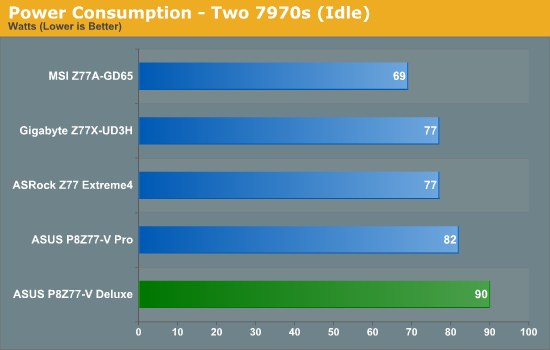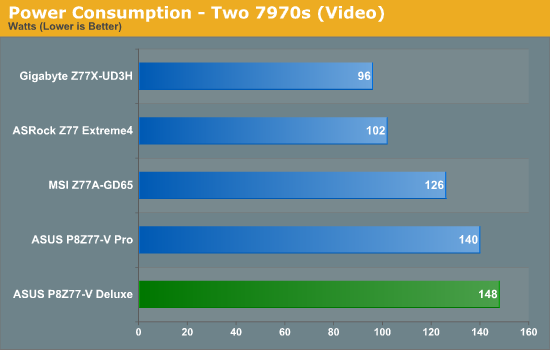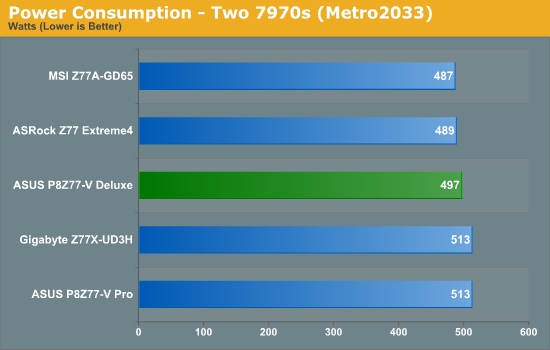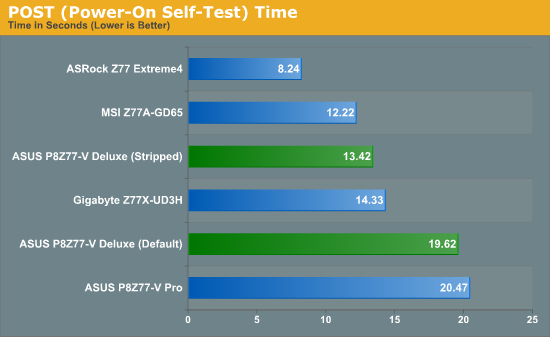ASUS P8Z77-V Deluxe Review - Know Your SKU
by Ian Cutress on May 12, 2012 8:45 AM EST- Posted in
- Motherboards
- Asus
- Z77
Test Setup
| Processor |
Intel Core i7-3770K ES 4 Cores, 8 Threads, 3.5 GHz (3.9 GHz Turbo) |
| Motherboards |
ASRock Z77 Extreme4 ASUS P8Z77-V Pro Gigabyte GA-Z77X-UD3H MSI Z77A-GD65 ASUS P8Z77-V Deluxe |
| Cooling | Intel All-in-One Liquid Cooler |
| Power Supply | OCZ 1250W Gold ZX Series |
| Memory |
GSkill RipjawsZ 4x4 GB DDR3-2400 10-12-12 Kit GSkill TridentX 2x4 GB DDR3-2666 11-13-13 Kit |
| Memory Settings | XMP (1866 9-10-9) |
| Video Cards |
ASUS HD7970 3GB ECS GTX 580 1536MB |
| Video Drivers |
Catalyst 12.3 NVIDIA Drivers 296.10 WHQL |
| Hard Drive | Micron RealSSD C300 256GB |
| Optical Drive | LG GH22NS50 |
| Case | Open Test Bed - CoolerMaster Lab V1.0 |
| Operating System | Windows 7 64-bit |
| SATA Testing | Micron RealSSD C300 256GB |
| USB 2/3 Testing | OCZ Vertex 3 240GB with SATA->USB Adaptor |
Power Consumption
Power consumption was tested on the system as a whole with a wall meter connected to the OCZ 1250W power supply, while in a dual 7970 GPU configuration. This power supply is Gold rated, and as I am in the UK on a 230-240 V supply, leads to ~75% efficiency > 50W, and 90%+ efficiency at 250W, which is suitable for both idle and multi-GPU loading. This method of power reading allows us to compare the power management of the UEFI and the board to supply components with power under load, and includes typical PSU losses due to efficiency. These are the real world values that consumers may expect from a typical system (minus the monitor) using this motherboard.




At lower loads, the power consumption on the Deluxe does seem a little high. This is due to ASUS' phase loading, in order to reduce the variation in voltages when lots of power is required instantly. This shows in the 2D benchmarks shown later in this review, which offer superior numbers.
POST Time
Different motherboards have different POST sequences before an operating system is initialized. A lot of this is dependent on the board itself, and POST boot time is determined by the controllers on board (and the sequence of how those extras are organized). As part of our testing, we are now going to look at the POST Boot Time - this is the time from pressing the ON button on the computer to when Windows starts loading. (We discount Windows loading as it is highly variable given Windows specific features.) These results are subject to human error, so please allow +/- 1 second in these results.

As requested, for future POST tests we will include an additional 'stripped' test, whereby controllers are turned off (USB 3.0, NIC, Audio, SATA Controller). The Deluxe is like the Pro, in that the onboard testing to make sure everything works takes an extra few seconds over other products.
Overclocks
Here at AnandTech we want to provide quick and easy ways to determine if a board is good for you (with in-depth analysis of course). So here is a quick round up of our overclocking results. Overclocks are tested for stability with PovRay and OCCT - while these may not be the most strenuous of stability tests, it does offer a quick check for memory errors under high load (and also balances testing time with getting the next board on for review!).
|
CPU Speed (MHz) |
Voltage (Volts) |
PovRay Peak Temp (ºC) |
OCCT Peak Temp (ºC) |
Notes | |
|
ASRock Z77 Extreme4 |
4700 | 1.175 | 86 | 86 | LLC Level 1 |
|
ASUS P8Z77-V Pro |
4700 | 1.200 | 83 | 86 | PLL Overvoltage enabled |
|
Gigabyte Z77X-UD3H |
4700 | 1.200 | 82 | 86 | LLC Extreme |
|
MSI Z77A-GD65 |
4700 | 1.250 | 90 | - | PLL Overvoltage enabled |
|
ASUS P8Z77-V Deluxe |
4700 | 1.225 | 89 | 84 | PLL Overvoltage enabled |










52 Comments
View All Comments
maximumGPU - Monday, May 14, 2012 - link
yes as Ian just said, my fans are 3 pin and plugged into the chassis headers. Fan Xpert can adjust their speed. i have a pwm 4 pin fan on the CPU header so can't tell you if that header can control 3 pin.i do not know how the control is done though.
DarkRogue - Monday, May 14, 2012 - link
All right, thank you to the both of you.I don't have any PWM fans, so I guess I will be the guinea pig for when I get the Z77 Deluxe board. It is good to know the other headers are capable of controlling regular 3-pin fans, though.
Ian, I know bugs are good to report, but I meant that a review of the software itself, such as the features it provides and how well it works, etc., would be a good supplement to a motherboard review. Again, the software is one other aspect the manufacturers are trying to differentiate themselves (I mean, look at the UEFI styles!) and it would be helpful to see how well their software works, or if similar things can be achieved with other software. Not everyone has used a board from every manufacturer before, nor know what use each piece of software provided is for, or how easy it is to use to achieve its intended function.
I just feel that with a review, it's helpful to review every aspect, and not just the hardware. Personally, I've never used any motherboard-supplied software because they've always been really buggy or annoying to work with, particularly Gigabyte's programs that kept auto-loading despite what I did until I just outright uninstalled it. It's been over 4 years since I've had an ASUS board, and I'll likely have to try AI Suite now to take advantage of Fan Xpert 2. Without seeing ASUS' video presentation of this feature, I would've skipped it and went with the cheaper Gigabyte board, and have to buy additional fan controllers, because Gigabyte's fan headers are apparently inconsistent.
Anyway, it's just a suggestion that, in my opinion at least, would give motherboard reviews a more 'complete' overview.
gtm - Monday, May 14, 2012 - link
I find Thunderbolt interesting for the ability to put one big and loud pc in one room, and get all I/O in another room, saving noise, space and cable mess.But is it possible to wake an hibernating PC using for example an USB-Keyboard connected to a thunderbolt display?
gtm - Monday, May 14, 2012 - link
Sorry, posted for the wrong articleSuuave - Monday, May 14, 2012 - link
I'm building a server with a similar board in this series. I've looked on the Asus site and several review sites. But I cant seem to find the answerMy question is what video card would the built-in video chip be equivalent to? I have an old GT 9600, but should I use it or would it just be a waste of time, energy and effort to install it?
Breaker - Wednesday, May 16, 2012 - link
Greetings Ian!In the OC section of your Asus Z77 Deluxe review you said:
adjusted the Turbo Ratio 1-Core Limit
Can you be more specific pls?
Shane527x - Wednesday, May 23, 2012 - link
Hi guys, I just ordered my board few days ago but i still disnt order the memory.. I want 16, i was thinking to make a 16g kit 8x2 vengeance corsairbut I didnt see anywhere. So id like to know if i can actually do that or what is the best? Thank youHardwareDufus - Wednesday, May 23, 2012 - link
I thought the UEFI initiative was to replace the BIOS, no?So all of these Z77 boards still have a BIOS? We will still have the excessive Boot times?
Triniman - Monday, August 13, 2012 - link
Will the Front Panel USB 3.0 box work with the P8Z77-V Deluxe motherboard? The reason I ask is that the listing of supported chipsets does not show the Z77 chipset and yet the P8Z77-V Premium motherboard ships with the Front Panel USB 3.0 box and it uses the Z77 chipset.Reference:
(http://ca.asus.com/en/Motherboards/Accessories/Fro...
macmuchmore - Tuesday, September 4, 2012 - link
I just purchased a P8Z77-v Deluxe for $224.99 this last weekend. I cannot wait to get it installed this week.So did I get a good deal? ;-)
macmuchmore